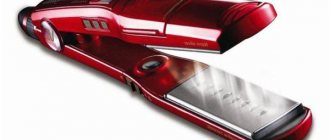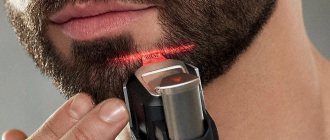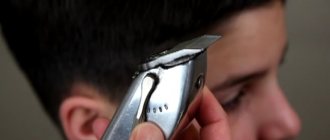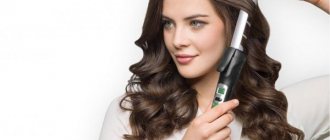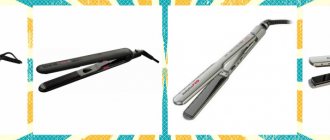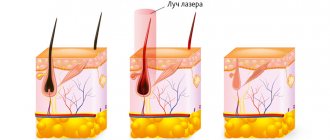Photoepilation is one of the safest, most effective and painless methods of hair removal. The popularity of this method is steadily growing every year. With the help of photoepilation, you can permanently remove hair from any part of the face and body, get rid of the problem of ingrown hairs and constant irritation after shaving.
The most popular are photoepilation of the deep bikini area (intimate photoepilation) and photoepilation of the armpits, which allow you to remove unwanted hair and feel confident in any situation.
How is the photoepilation procedure performed?
The procedure is shown in the following photographs:
Before the session begins, the doctor clarifies all indications and explains contraindications for the procedure, determines the necessary parameters of the procedure depending on the skin phototype, hair color and thickness. For maximum effectiveness of the photoepilation procedure, the hair length should be no more than 1-1.5 mm. With longer hairs, some of the energy is dissipated while it reaches the hair follicle, which leads to a decrease in the intensity of the effect. Therefore, if the hair length is 3...5 mm or more, it is necessary to shave it or remove it with depilatory cream 2 days before the procedure.
Attention!
It is prohibited to pluck or pull out hairs during the course of photoepilation, or to use wax, sugar and other types of hair removal associated with the removal of the hair root.
The patient should definitely wear special dark glasses to protect their eyes from bright flashes. Before starting the procedure, the doctor applies a transparent cooling gel to the skin, which absorbs the thermal energy released during the outbreak and eliminates possible negative consequences. The specific area is then treated with flashes of light of a specific area. After the photoepilation procedure, a soothing lotion or cream is applied to the treated area.
Features of photoepilation
Hair length and color
A lot depends on the hairs, including how many procedures will ultimately be required. To carry out photoepilation, they must have a certain length. 1-2 mm is considered optimal. This is enough for light energy to selectively affect the melanin pigment. With longer hair, a certain amount of the energy dissipates as it reaches the follicle. This leads to a decrease in the intensity of the impact. That is why it is recommended to shave your hair a couple of days before the procedure. In this case, there should be no cuts or abrasions in the treated area.
Photoepilation works best on dark hair and light skin. For light brown, gray or red unwanted hair, the procedure is ineffective, since such hairs have little or no melanin pigment.
Feel
Photoepilation occurs without violating the integrity of the skin, so in general it is painless. However, some people feel slight tolerable discomfort during it, since everyone’s pain threshold is different. Moreover, with each procedure, sensitivity decreases as the skin adapts. This distinguishes photoepilation from laser hair removal, which is quite painful.
What are the advantages of the iPulse photoepilation device (England)?
| Our center uses the latest photoepilation device iPulse (England), which has the largest flash area of 9 cm2, which requires significantly fewer flashes to treat various areas compared to other devices (most devices have a flash area of up to 3 cm2). Therefore, the speed of the procedure is much higher. For example, photoepilation of the legs takes about 30 minutes, and photoepilation of a deep bikini takes only 15 minutes. It should also be noted that the procedures are well tolerated and painless due to the simultaneous cooling of the treated area. |
How many sessions are needed to permanently remove hair?
Treated hair that was in the growth stage is removed permanently.
After they fall out, nothing else grows in this place.
The period after which hair falls out after photoepilation is approximately 2 weeks (from 10 to 14 days).
Did you know? The problem of body hair growth has been elevated to one of the most pressing. Fashion dictates the need to have a smooth body, which millions of women and even men strive for. Today the turnover of the hair removal market in Europe is about 7 billion US dollars per year. The global volume is $90 billion. Therefore, this procedure can be offered in any beauty salon.
Number and duration of procedures
For photoepilation to be effective, it is necessary to withstand the required number of flashes. This indicator depends on the skin type and the area being treated. The more delicate the skin, the fewer there should be.
On average, three to ten procedures are required depending on the area of the body, and between sessions it is necessary to maintain an interval of 20-30 days. One session takes about an hour and a half, again depending on the area where you need to get rid of unwanted vegetation.
Why is hair not completely removed immediately after the first procedure?
A pressing question among salon clients is why photoepilation is ineffective after the first procedure. The fact is that only those hairs that are in the active growth stage are exposed to light. The hair that was in a dormant state, which was about 80%, did not absorb light. Over time, they germinate and a repeat procedure is required.
In addition, its ineffectiveness may be due to other factors. For example, when an insufficiently powerful device is used. It must emit impulses of at least 25 J/sq. cm.
The problem may also be that the device is not configured for this type of skin and hair. In some cases, the device does not have such functions, in others the cosmetologist is not experienced enough to set it up correctly.
Also, due to the low qualifications of the cosmetologist or his poor knowledge of a specific model of the device, the hair follicle may not be completely destroyed . As a result, the hair is not completely destroyed, but only slightly damaged. Therefore, it is very difficult to say exactly how many flashes are needed for photoepilation.
How long does it take for hair to fall out after epilation?
After the first procedure, approximately 20% of all hair falls out, but up to 100% of all hair that was above the surface of the skin at the time of treatment. Hair does not fall out immediately, but within two weeks after the procedure (from 10 to 14 days), so after photoepilation it can be removed every other day with a cream or razor, but you cannot pluck it or use an electric epilator.
How many treatments are needed?
In order to get rid of unwanted hair forever, the photoepilation procedure should be repeated 6-8 times depending on the treated area with an interval of 1-1.5 months, and then maintenance procedures on average once a year. This is due to the fact that under the influence of light, only those bulbs are destroyed that were in the active growth phase (anagen), when the hair grows and comes to the surface of the skin and is able to “conduct” the energy of the impulse to the hair follicle. The so-called “sleeping” bulbs, from which the hair has not yet grown, are not affected, so it is necessary to maintain a certain interval (1-1.5 months) for the appearance of new hair - conductors of impulse energy on the surface of the skin.
Thus, the number of procedures and the intervals between them depend on the time of maturation of the bulb and the appearance of new hairs on the surface of the skin. It should be noted that hair growth periods differ in different parts of the body. On average, the development cycle of a hair is 6-8 months from the moment it falls out until a new one grows from the same bulb. This determines the number of photoepilation procedures.
The number and frequency of procedures are individual and depend on many reasons:
- hormonal levels that determine the degree of hair growth
- constitution, age and gender of a particular person
- use of certain depilation methods before the photoepilation procedure.
How to choose a photoepilator?
In order not to be disappointed in photoepilation and to get rid of unwanted hair for a long time, you need to choose a good epilator. Main criteria:
- Safety - the Beurer IPL 5500 Pure Skin Pro photoepilator has a sensor that detects skin color and protects heavily tanned areas from treatment;
- Compactness - small devices allow you to process even hard-to-reach places, and they are convenient to take with you on trips;
- Working area of the lamp - the larger it is, the less time the procedure will require;
- Number of flashes - each device has a certain resource;
- Flash power and interval between them;
- Adjusting flash intensity.
Modern photoepilators have many additional functions that can be very useful. For example, the Beurer IPL 9000+ SalonPro System model has a filter that protects against the harmful effects of ultraviolet radiation. And photoepilators from this manufacturer are synchronized with the beurer MyIPL application, which tells you how to carry out photoepilation at home at a professional level. It would be a good idea to study reviews of several devices.
How often can photoepilation be done?
Dermatological specialists do not recommend overusing frequent hair removal. Different areas of the body are characterized by specific hair growth. In women, hair grows most intensively in the eyebrow area, and more slowly on the chin. Regular procedures, provided there are no hormonal changes, significantly reduce hair growth.
To avoid trauma to the epidermis, it is better to entrust the photoepilation procedure to a professional cosmetologist in the aesthetic medicine service. The doctor will professionally determine the frequency of necessary procedures in accordance with your skin type, hair, hair removal area and create an individual program of visits. Most often, photoepilation is prescribed in courses of 8 to 15 sessions at intervals of 1 month.
Photoepilation procedure
Preparation for the photoepilation procedure
you need to start at home. 2-3 days before going to the cosmetologist, you should shave the hair in the area in which you plan to permanently remove unwanted hair. A length of a couple of millimeters is necessary for the best absorption of light energy from the device by the hairs.
You should also abandon all methods of hair removal, other than razors, about a month before the start of the course of photoepilation procedures.
The mechanism of the photoepilation procedure itself is quite simple. A cosmetologist asks the patient to wear special glasses to protect his eyes from photo flashes. After this, the doctor begins to treat the selected area, making successive flashes throughout the entire treated area. The flashes cover fairly large areas, so that the procedure for even large areas of the body (for example, legs) takes about 15-20 minutes.
The course is always selected individually. You may need from 8 to 15 sessions, the interval between which will be about 4 weeks.
What is good about photoepilation and what are its features?
Firstly , photoepilation, like laser hair removal, gives a longer lasting effect than the usual “home” procedures (shaving, waxing). But, unlike laser hair removal, photoepilation has virtually no side effects. The most you may encounter is redness and slight swelling, which will go away shortly after the procedure. When removing hair in sensitive areas (for example, the groin), slight pain may occur.
Secondly , during photoepilation, hair is not simply removed, but hair follicles gradually begin to atrophy. In place of terminal hairs, vellus hairs grow. Of course, no procedure will get rid of your hair forever, but after 3-5 sessions of phototherapy, hair does not grow back for about seven months. After laser hair removal, the number of hairs is also reduced, but this requires 20 procedures, which can harm the skin.
Thirdly , the photoepilation device - a high-energy pulsed lamp - does not have a targeted effect, like a laser, but a wider one - up to 4.5 cm. Moreover, the time between pulses is from 2 to 5 seconds, which gives the skin the opportunity to recover.
| PROCEDURES |
| Photoepilation |
| Laser hair removal |
| Hardware depilation |





